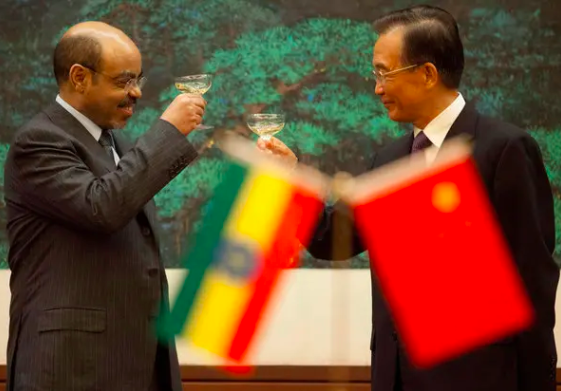
Photo Credit: The New York Times
Natural Allies: Reconstructing the Africa-China Relations for Sustainability
by Charles Okeke
191pp.
This book echoes the sentiments of many: involvement with China has been, for the most part, a good decision for developing African economies. Written by a China-based African scholar, Natural Allies aims to provide some fresh perspective on China-Africa relations.
The introduction offers a summary of the book’s purpose – to review the actions that made China a success story, and how Africa can adapt some of these political and economic policies to its own context and benefit.
It also highlights a key commonality in the origin of modern China and Africa countries as victims of European imperial exploitation, as well as the role of African countries in China’s ascent into the UN. It also points out the Chinese contribution towards the independence of African countries and the institutional frameworks, such as FOCAC and BRICS, through which the relationship has been conducted.
The author also frames the situation between Africa and its main foreign partners, the EU, the US and China as one where Africa has to choose because it needs only China:
“The U.S offers technical support to Africa, while EU especially France supports with military and intelligence but China with its soft power and economic partnership appears to be the only plausible ally Africa needs moving forward ”
This assertion ignores the importance of the EU and US in African affairs, especially in the areas of trade, security and investment.
There are other quotes which require repurposing and adequate defence. The introduction fails to identify what exactly makes Africa and China natural allies, which is worrisome as this makes up part of the book title, and thus could be viewed as misleading the prospective reader. It also omits Russia’s considerable influence as a key player in China’s political stakes.
The next chapter, Africa and China Relations in Retrospect, offers several accurate posits regarding how China’s strategic interests align with Africa’s, as the relationship is not based on a past of imperial control, but on attempts to best synergise interests.
However, the jump to a retrospective view of Sino-African relations may be jarring, as there is no appropriate build-up; perhaps a more-detailed preliminary chapter on past Africa-China relations and how things have (or have not) changed would be a beneficial addition, rather than the brief history summary given in the introduction.
The structure of the book is passable, but further editing to ascertain a more logical chapter arrangement may be necessary. Written in a first-person tone, the book aims to be formal but sometimes comes off as informal, as evidenced in this questionable postulate from the introduction:
“China and Africa bond has gone beyond just victims of same European imperialism or oppression but into a more―siblings kind of relationship. The rate of African leaders visit to Beijing and the number of times past and present leaders of China has visited Africa validates my claim.”
It bears mentioning that a rise in trade and high profile diplomatic visitations is not sufficient to declare both Africa and China as ‘siblings’.
Also, more excerpts and references with infographics may be useful to the visual reader, as the oft discussed aspects of trade, involving large financial and or commodity exchanges over the years may require bar charts or other such descriptive media for easier visualisation.
The third chapter brings into focus the economic dimension of Sino-Africa relations. The author presents facts and figures to describe the origin and nature of China’s economic ties with Africa. The author posits that China intends to show Africa a viable alternative to western economics. The TAZARA, which is one of the earliest Chinese funded capital projects in Africa, example is given. TAZARA was a Tanzania-Zambia railway project to link copper rich Zambia with a port in Tanzania. Zambia’s goal was to boost its export of copper in the 1960s when the price of copper skyrocketed. The World Bank declined to finance the project, then China stepped in with a thirty-year interest-free loan that was used to construct the railway to completion in 1975.
This chapter goes further to discuss the foundation and institutionalisation of Sino-Africa economic relations by talking about FOCAC and how it has served as a mechanism which allows for bilateral agreements on projects across the continent.
Perhaps to offer a balanced perspective on Sino-Africa economic relations the author makes mention of the effect of cheap Chinese imports on Africa’s indigenous textile, footwear and clothing industry.
The fourth chapter was well written and convincing; it starts off by exploring Africa-China cooperation in world politics. The author quotes Chairman Mao: “It is our African friends who have brought us back to the United Nations” to highlight the important role independent African nations played in the emergence of modern Chinese state in global politics. He also noted that China played a role in Tanzania’s Salim Ahmed Salim being elected Secretary-General of the United Nations in 1962. The author goes on to give a quick glance of China’s foreign policy in relation to Africa: Debt reduction and Afro-optimism are two of the seven listed policy principles. The former was a surprise to me, given the geometric rise of Africa’s indebtedness to China.
The next Chapter was about migration between Africa and China, but largely glossed over the topic. Then the book dives deep into some of the main issues that dominates the China-Africa relations debate.
One is the dumping of cheap Chinese imports and their impact on textile and clothing industries across Africa. The author’s coverage of the issue is hardly a defence of the Chinese nor a harsh criticism of government on both sides of the equation. Regardless, the author’s approach to the issue offers a good explanation for anyone seeking to understand how Chinese goods benefit Africans because they meet Africa’s needs at a relatively low price point. He goes further to mention the push back from many African countries who have filed complaints against China with the World Trade Organisation (WTO). Perhaps in an attempt to clear any assumptions that dumping is illegal, the author points to the fact that dumping is not prohibited under the policies of the WTO.
The book’s coverage of the Belt and Road Initiative (BRI) was written from the perspective of how Africa fits into the mega project which China hopes will transition its economy into a fully industrialised one. The author states that Egypt, Djibouti, Ethiopia, Tanzania, Zambia and Angola are the countries Chinese business critical to the BRI will be located. The omission of Kenya from the list of countries can’t be ignored, as Kenya’s Lamu port is what really anchors Africa to the maritime Silk Road. Although he later mentioned that a Chinese news outlet reported that Kenya was one of the countries currently benefiting from the BRI. What is missing from the author’s take on Africa’s place in the BRI is a clear distinction between which Chinese funded projects are primarily for BRI and which are built specifically for the interest of African countries. Such a distinction would have gone a long way in addressing critics who draw comparison between infrastructures built by colonial powers – to extract resources from Africa – with today’s Chinese funded infrastructure.
The title of chapter eight, “Africa-China relations: not a win-win affair” sees the author argue that Africa is getting the shorter end of the stick in its relationship with China. Here the author China’s environmental and labour disaster in Africa and how Chinese development aid may be counterproductive.
Towards the end of the book the author explores the areas China can assist Africa, if the relationship is ever to become a win-win. He highlights the role China can play to facilitate Africa’s industrialisation. For example, China has been involved in building industrial parks in countries like Ethiopia and Nigeria. More of such projects can reflect China’s commitment to the industrialisation agenda of African countries.
Technology transfer is another area the author argues China can do more to make balance its relationship with Africa. However, the book seems to consider having more Chinese technology firms expanding operations across the continent as equating to technology transfer, as opposed to handing over scientific knowledge via training, cooperation in research and development and joint ownership of technology via African investment.
The following chapter presents Chinese military activities (the most visible is the Chinese military base in Djibouti) in Africa as something Africans should welcome. Although military cooperation isn’t inherently a bad thing, the book did come off as a calculated defence for Chinese military expansion into Africa; it describes China’s defence policy in Africa as unique without any substantial evidence to back the claim.
In chapter 11 the book discusses Africa within the context of geopolitical contestation between global powers. The scramble for Africa is an old problem, and China, the relatively new kid on the block, is presented as Africa’s partner of choice. Some of the reasons given are convincing, the author points to China’s remarkable investment in building infrastructure across Africa over a short period of time. Also China’s emphasis on trade as opposed to aid makes China a suitable partner for Africa. The book goes on to examine Africa’s relationship with other global powers like the European Union, the United States, and India, but with a special focus on criticisms coming from the US about China’s growing presence in Africa.
Many African observers still point to euro-centrism as one of the reasons postcolonial Africa has remained underdeveloped. So, the audacity of the author to offer sino-centrism in the concluding chapters as a way forward for Africa has to be applauded.
However, while the book draws similarities and differences between Africa and China, it fails to clearly discuss how the differences between Africa and China could impact the former if it goes on to emulate China. Beyond investments and infrastructure, the geopolitical impact should Africa adopt the Chinese model and/or prioritise Chinese-led platform for international cooperation like BRICS were not deeply discussed.
The pro-China intent of the book is evident, but it may benefit from further editing of the tone to reflect the gravity of the subject, as well as a subchapter detailing the less beneficial aspects of Sino-African relations in current years (to provide a more balanced perspective). Also, the book seems a bit rushed; proper defence of several arguable quotes with appropriate numeric referencing in the footer sections of the pages is required, to improve the professional bearing of the text.
There were many points in the book when the author made it seem as though Africa is one country with one government, due to how he repeatedly emphasised what Africa should do or what China should do in dealing with Africa.
The book also makes assumptions of the reader’s understanding of complex policy issues surrounding Sino-African relations, and may benefit from a minor paragraph in its Introduction, offering links to catch-up documents or starter books for the policy novice. ✚

Eguegu is an analyst and adviser that specialises in addressing geopolitics, international policy and security problems.


